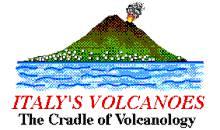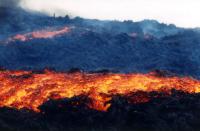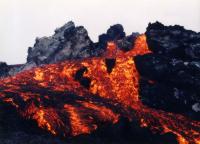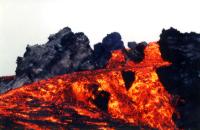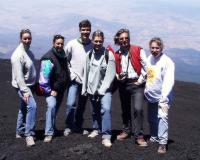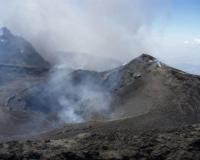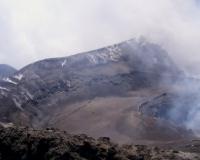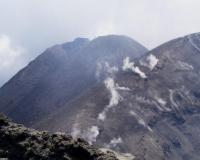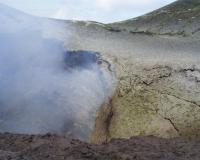|
Archived Etna news
|
Do you plan to visit Etna
in the near future?
Check the weather
forecasts for the Etnean area!
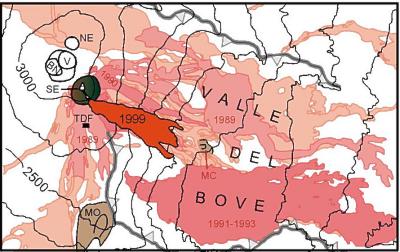
Sketch map of the
Valle del Bove and area of the lava flow-field emplaced since 4 February
1999, situation as of 4 June 1999.
The
lavas erupted during the period 1989-1993 are shown in various shades
of pink, previous flows (since 1971) are shown in brighter color. 1995
to early 1999 lavas are not shown. NE=NE Crater; V=Voragine; BN=Bocca
Nuova; SE=SE Cone; TDF=Torre del Filosofo; MO=Montagnola; RS=Rifugio
Sapienza (only in large version of the map); MC=Monti Centenari. The
large version of this map shows a larger area, a scale bar and an index
map.
|
WARNING: Access to the summit craters is again becoming INCREASINGLY DANGEROUS. Explosive activity has resumed within the Voragine, and some bombs are ejected beyond the crater rim. Magmatic activity is also occurring deep within the active pit of the Northeast Crater and deep within the northwestern vent of the Bocca Nuova. Besides this, weather conditions are often unstable. Any person who enters the area beyond the Torre del Filosofo mountain hut (2900 m elevation) goes at his/her own risk and is not covered by any insurance in case a rescue operation (e.g., with helicopters) is necessary. The same is true for those who try to get close to the still-active effusive vents on the Valle del Bove slope. |
Update on the activity on 9-11
July 1999. Boris Behncke (Dipartimento di
Scienze Geologiche of Catania University), Peter Ippach and Eduard Harms
(Deutsches Vulkan-Museum - German Volcano Museum - Mayen, Germany) visited
the summit area again on 9 and 10 July, and additional informations
about the activity on 10-11 July were provided by Giuseppe Scarpinati,
(Association Volcanologique Européenne - LAVE - Paris, France),
and Charles Rivière (of Tremblay-en-France, France). Observations
by Behncke, Ippach and Harms were restricted to the area of continuing
lava emission at the 4 February fissure at the southeastern base of
the SE Cone, but Rivière visited the summit craters early on
10 July.
At the 4 February fissure, three effusive vents were active at the same
site where lava emission was observed on 7 July (a tumulus about 150
m downslope from the uppermost hornitos formed in February-March), and
a small hornito about 25 cm high that lay in a small depression a few
meters south of the effusive vents had weak explosive activity. Two
of the lava flows emitted from the effusive vents merged a few meters
downslope, forming a broad lava river (up to 3 m wide) that flowed ENE
for a few hundred meters. The third lava flow which was much less vigorous,
issued from a small vent and then entered a lava tube from which it
re-issued about 30 m further east, forming a sluggish flow. Another
lava flow that came from a vent about 100 m upslope from the three effusive
vents slowly moved across previous lavas, and incandescent lava was
seen in many other places on the lava field formed since 4 February.
The next day, effusive activity occurred from one main vent on the tumulus,
with lava flowing in a well-defined channel about 0.5 m wide; a second
vent added fresh lava to this flow some 5 m downslope. During four hours
of observation, the effusion rate was seen to fluctuate as the level
of lava in the flow channel was seen to rise and fall by as much as
20 cm. Lava was also observed to issue from several ephemeral effusive
vents further downslope along the northern margin of the lava flow-field.
Charles Rivière who had visited the summit craters during the
forenoon of 10 July reported that there was continuous pyroclastic activity
deep within the pit of the NE Crater, but no pyroclastics were ejected
above the rim of the pit. In the Voragine, Strombolian activity occurred
from both the central and the "diaframma" vents, with bombs
at times rising high above the crater rim; Rivière noted that
explosions occurred about every two minutes.
Giuseppe Scarpinati and Alain Catté observed the effusive activity
during the late afternoon and evening of 10 July, and during the morning
of 11 July. Shortly after 1800 h on the 10th, the tumulus where the
main effusive vent had been emitting lava was seen to "inflate
rapidly, and then lava came down on all its sides, forming three lava
rivers". One vent on the top of the tumulus produced high-pressure
gas emissions. Different from the tumulus collapse observed by Behncke
and Scarpinati on 12 May (see the 12 May
update), this time the tumulus did not collapse.
On the next morning, none of the vents on the tumulus were active, but a new effusive vent had formed some 30 m to the southeast, burying the path on which tourists had been brought to the effusive vent area during the preceding days. Lava effusion from this new vent was vigorous at about 0600 h but diminished later that morning.
Update on the activity on 6-7
July 1999. The summit area was visited on
6 and 7 July by Boris Behncke (Dipartimento di Scienze Geologiche of
Catania University), Peter Ippach and Eduard Harms (Deutsches Vulkan-Museum
- German Volcano Museum - Mayen, Germany). During the first of these
two visits, activity in the NE Crater and the Voragine was observed.
There was strong gas emission from vents on the floor of the NE Crater's
central pit, and every 10-45 minutes there were explosive ejections
of rocks and ash emissions. It is not known whether the ejected rocks
were derived from fresh magma, for they did not rise as high as the
rim of the pit, but the gas plume issuing from the pit was heavily charged
with sulfur dioxide. In the Voragine, explosive activity at the "diaframma
vent" had decreased, and only one explosion was observed during
two hours of direct observations. However, the central vent which had
been inactive during Behncke's previous visit on 1 July and Grandpey's
2 or 3 July visit (see update below) was the site of Strombolian eruptions
that occurred at intervals of 1-10 minutes. Incandescent bombs were
ejected but only in one case rose as high as the rim of the vent which
was estimated to be at least 35-40 m deep and which had a pit about
5 m wide in its floor. During most eruptions bombs were ejected obliquely
from a vent located on the northern side of the conduit. The largest
eruption, though, was vertical. All eruptions were accompanied by loud
degassing.
Bombs that had been ejected recently, but surely several days before
the visit, littered most of the Voragine floor. The largest of these
bombs were 1.5 m long, and many had created spectacular impact craters.
It appears that, although activity in the summit craters is increasing,
the activity has fluctuations, and the trend is not linear.
The 7 July visit to the 4 February fissure disclosed continuing effusive
activity from two major effusive vents, one located in the area of the
hornitos that formed in the past few weeks (minor spattering had occurred
as recently as 4 July), while the other lay about 100 m downslope. This
latter vent was at the end of a lava tube that had formed recently.
The lava that issued from this vent appeared to be more fluid than lavas
erupted during the first months of the effusive activity initiated on
4 February. Samples taken from the vent are glassy and contain no phenocrysts.
Lava issued from the vent at a rate of about one cubic meter per second
while the effusion rate at the higher vent was lower. During four hours
of observations at the effusive vents, explosion sounds coming from
the Voragine (and maybe also from Bocca Nuova) were heard at intervals
of 5 to 45 minutes, and Claude Grandpey who had been at NE Crater and
the Voragine reported that the former had periodically emitted ash while
in the Voragine activity had again shifted to the "diaframma vent".
Update on the activity on 2-3
July 1999. The following is based on a report received by
telephone from Claude Grandpey, member of the French Association Volcanologique
Européenne (LAVE) on 4 July 1999.
Grandpey visited the 4 February eruptive fissure on 2 July and observed
vigorous lava emission but no pyroclastic activity. The next day, lava
emission had decreased, and there was no pyroclastic activity as well.
Activity was intense at the southwestern vent ("diaframma vent")
of the Voragine, with explosions ejecting bombs outside the crater on
the northern side of the vent. Many bombs were also observed to fall
into the Bocca Nuova. Grandpey warned that people should stay away from
the northwestern rim of the crater due to the falling bombs. The central
vent in the Voragine had periodic gas and ash emissions but did not
produce eruptions. In the Bocca Nuova, noisy activity occurred in the
southeastern vents (which during the 1 July visit reported below only
emitted ash) while the northwestern vent was relatively quiet.
A note from the author of this web page (Boris Behncke): During the week 29 June-3 July, I am making numerous excursions to Etna (including the summit area and its flanks) with a group of German students who are involved in the Students' Volcano Monitoring Project (their homepage is in German language) at the Gymnasium Heidberg (Hamburg, Germany). We have visited several areas of historical flank eruptions (e.g., the Monti Sartorius of the 1865 eruption) and been at the summit twice, a third summit visit is planned on 3 July. We noted that the activity at the summit craters is definitely increasing and may be heralding a new period of intense activity in the summit craters, similar to the periods of July-December 1997 and May-September 1998.
Report on the activity observed
on 29 June 1999. This visit was made during the afternoon
and evening of 29 June, ten days after the latest summit visit by Behncke.
During the visit, the 4 February fissure at the southeastern
base of the SE Cone, had one eruptive site that produced mild
lava spattering and two lava flows; this was located about 1-2 m upslope
from the large hornito seen in activity during the 19 June visit. Spattering
occurred from three closely-spaced vents, and blobs of lava were thrown
up to three meters from their source vents. One lava flow moved northwestwards
for about 20 m before turning north and then northeast, it had advanced
only about 100 m from the source vents. The other flow moved eastwards,
and it appeared to have traveled much farther downslope, but not yet
arrived on the western rim of the Valle del Bove. A partially drained
lava tube containing incandescent but stagnant lava was seen some 50
m downslope from the active vents. The activity observed during that
visit was some of the most vigorous ever observed after the first few
weeks of the effusive activity initiated on 4 February. The output was
estimated at 1-3 cubic meters per second.
After hearing repeated loud explosions from the Voragine area, three
of the visitors (including Behncke) climbed to the eastern rim of the
Voragine, a difficult task due to very strong wind from the west-northwest.
The southwestern ("diaframma") vent in that crater produced
loud explosions every 2-10 minutes, which ejected incandescent bombs
to above the vent rim, but none were observed to rise as high as the
rim of the crater itself which contains this and another large vent
active during the summer of 1998. Some explosions consisted of a brief
expulsion of incandescent bombs accompanied by a loud bang, while others
consisted of a more prolonged emission with a rushing sound, and these
latter ejected incandescent material to much lesser height.
Observations of the other summit craters (Bocca Nuova and NE Crater)
were not possible due to the strong wind and the falling night, but
the SE Cone was seen to be completely quiet when observed from the terrace
in the southeastern part of the summit crater terrace.
During fieldwork at the Monti Sartorius (or Sartorio) on the northeastern flank of Etna (at about 1600 m elevation) during the afternoon of 30 June, one loud explosion, probably from the Voragine, was heard.
Report on the activity observed
on 1 July 1999. The ascent was made from Piano Provenzana
on the north-northeastern side of Etna, and the NE Crater, the Voragine
and Bocca Nuova were visited. Observations were made during four hours
from 1130 until 1530 (local time = GMT+2). The visit benefited from
perfect viewing conditions and very little wind, a rare phenomenon on
Etna.
The NE Crater, last seen by Behncke on 5 October 1998, had changed
little since that visit. Its generally flat floor (covered by pyroclastics
from the 22 July 1998 eruption of the Voragine) was pierced in its southern
half by a large pit from whose floor a dense gas plume charged with
sulfur dioxide was emitted at high pressure and with a noise similar
to that of surf. While the crater floor was not visible, probably because
it lies at more than 100 m depth below the northern rim of the pit,
no ejections of solid material were observed, but some lithic blocks
lay around the pit's rims. The loud, surf-like noise has been heard
also during periods of heightened activity in October 1995 (just before
the crater initiated a series of paroxysmal eruptive episodes that lasted
through June 1996) and in July-August 1997, when the magma level stood
only a few tens of meters below the rim of the pit. There were periods
lasting a few minutes when the noise level increased notably, and the
gas plume rising from the pit became much denser; at one time it contained
brownish ash.
Bocca Nuova had its usual two large eruptive centers, one in
its northwestern part and the other at the base of its southeastern
rim. While the latter periodically emitted plumes of grayish-brown ash,
the former was the site of alternating ash emission and magmatic degassing
at depth. At least three vents were seen in the cone that formed in
1998 at this eruptive center, one lay on its northern rim while the
other two lay deep in its central part. During periods of relative quiet,
bluish gas issued, at times under pressure, from the two deeper vents.
Deep explosions from these vents did eject material to below the cone's
rim (this could be ascertained from the sound of falling rocks) and
were followed by prolonged ash emission from the vent on the cone's
northern rim. This is the first evidence of magmatic activity (except
a brief glow observed by Guest and Duncan in early June) in the Bocca
Nuova since early February.
The Bocca Nuova was seen to be mainly unchanged since last observed
at good viewing conditions in late January; in spite of the withdrawal
of the magma column after the onset of the fissure eruption on 4 February,
no general subsidence has occurred at this crater.
The most intense activity was occurring in the Voragine. This
crater, according to one of the mountain guides of Piano Provenzana,
had intensified its activity on 26 May. During the following days the
activity fluctuated but showed a general increase, and on the morning
of 1 July the activity was described as particularly intense. When observed
from the southern side of the NE Crater, explosions occurred at the
"diaframma" vent every 1-10 minutes, being very similar in
frequency to those observed two days before, but ejecting material considerably
higher. It was further noted that the central vent in the Voragine which
had remained quiet since October 1998, produced periodic emissions of
dense gas plumes indicating that this vent was reopening, but there
was not yet any eruptive activity at this vent.
The "diaframma" vent was then observed at close range, from
the southwestern rim of the Voragine. Explosions started with a noise,
at times just a sudden loud detonation, at other times consisting of
a prolonged hissing or rumbling, followed within seconds by the appearance
of large bombs that rose tens of meters above the vent, and sometimes
even tens of meters above the crater rim itself, and then by a rising
plume of brownish ash. No pyroclastics fell onto the southwestern crater
rim, but a few very fresh, and highly vesicular, bombs were found up
to 30 m downslope on the outer southwestern slope of the Voragine. Some
explosions also dropped bombs into the neighboring Bocca Nuova.
From a morphological aspect, the Voragine appeared essentially unchanged
since last seen during good viewing conditions by Behncke and Sturiale
on 21 January.
The gradual reactivation of the summit crater complex of Etna has been
heralded in the past four weeks by signs of increasing gas emissions
and a higher output of the 4 February fissure which is clearly connected
with the central conduit system, although it appears that this connection
now mostly concerns Bocca Nuova and the Voragine. The intensification
of summit explosive activity may be due to the uprise of a new batch
of gas-rich magma and to the fact that less lava emerges from the 4
February fissure than is rising to the surface. The evolution at the
summit craters (except the SE Cone which appears to be perfectly quiet
to the moment) is extremely similar to that of the spring-summer 1998:
in May, explosive activity at the "diaframma" vent in the
Voragine increased, followed by renewed magmatic activity in the Bocca
Nuova, and then a resumption of activity of the central vent in the
Voragine which had previously erupted from July to at least November
1997. The activity increased gradually through mid-July and culminated
in the powerful paroxysmal eruptive episode at the Voragine on 22 July
1998. It is not clear if the summer of 1999 will see similar phenomena
- it has to be considered that part of the magma may drain through the
still-open 4 February fissure - but after seeing quiet lava effusion
for almost five months without significant explosive activity at the
summit craters, many Catania-based geologists wished to see the spectacular
explosive activity return to the summit craters. This appears to be
the case now, and it is well possible that this page will bring the
reports of new awesome activity in that area in the near future.
visitors counted since 12 February 1999
(more than 10,000 during the first 3 weeks!)
FastCounter
by LinkExchange
Page set up on 27 May 1997, last modified on 15 July 1999
